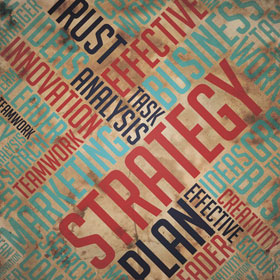Marketing is an important process for all small businesses, whether you’re trying to cultivate new customers or aiming to stay top-of-mind with your existing customers. It encompasses everything from the products and services you offer, to what you charge for those products and services, to how you promote them to your audience and how they are delivered.
As a small business owner, that can seem like quite a lot. But, we’re outlining the 5 key elements of a small business marketing plan, to help you organize all that information into a solid plan that your company can build from.
 1. Strategy
1. Strategy
Your marketing strategy will establish the foundation for setting the goals and objectives of your marketing program, identifying your audience and developing your narrative.
What do you want your marketing plan to do? Build brand awareness, generate sales leads, grow revenue or bring more traffic to your website or physical location?
Who is your audience? Are they professionals, young moms, or millennials? Are they highly educated? What is their annual income?
What will your messages be based on? Will you be providing potential customers with useful information? Positioning your business as an expert in the industry or focusing on quality customer service?
These are all questions that should be considered and outlined in your small business marketing strategy.
2. Capacity
Once you have your overall business strategy in place, you need to develop the talent, processes and resources to consistently deliver on your goals. It’s tempting, when starting your own business, to be a jack-of-all-trades. But to effectively run a business, you’ll need a team made up of professionals with different areas of expertise. Someone who has a head for analytics may not have the detail-oriented mindset to run a multi-faceted marketing campaign.
And neither of those professionals may possess the skills it takes to develop and nurture customer leads that your marketing generates for your business.
Hire smart, dedicated people, and then let them do what they do best! If you find you don’t need a “full-time staff”, search out dedicated resources who you can hire on a temporary or project basis.
 3. Content
3. Content
Have you heard the phrase “Content is King?” Content delivery may seem like a trending tactic, but fledgling companies like John Deer, Jell-o and Proctor & Gamble are credited with some of the earliest examples of content creation, dating back to the early 1900s.
Do you want to establish your business as upscale, budget-minded, or middle-of-the-road? This is your chance to set the groundwork for your “business brand.” Your brand identity is how you want to be known. It’s how you present your business to consumers. Then, how it is perceived by the consumer, what they feel your company stands for, and what perceptions your customers develop in their minds about your company, is the brand image.
You should strive to educate and engage your various audiences. It’s tough to stand out from the crowd so be sure you have something original to offer, or at least be able to communicate your business in a new, interesting and engaging manner. Make it part of your “brand”.
4. Platform
Now that you know what your message will be, you need to identify the best platforms for delivering your content out to your audience. For this step, it’s crucial to know and understand your audience. But you have to go beyond demographics like gender, level of education, age, and location.
 You need to know how they spend their free time. Are they online? What TV programs are the interested in? What social media channels are popular with this group? What publications do they read? Do they read online or printed?
You need to know how they spend their free time. Are they online? What TV programs are the interested in? What social media channels are popular with this group? What publications do they read? Do they read online or printed?
In the past, traditional marketing platforms were the ideal way to reach potential customers. Traditional marketing is what you recognize as newspaper or magazine advertising, radio advertising, billboards, or direct mail. And while these can still be important tools in your marketing plan, it’s necessary for you to also branch out into digital marketing platforms. Digital marketing channels include your company’s website, email marketing campaigns, blogs, and social media marketing.
5. Evaluation
Finally, you’ll need to develop metrics to evaluate the efficiency and impact of your marketing plan. By determining whether the messages or platforms you’ve chosen are resonating with potential customers, you’ll be able to determine if your marketing dollars are being utilized properly.
One way to determine which marketing platforms are working and which are not, is to track each marketing piece. Adding a unique, “vanity” phone number or website address in your print or radio advertising allows you to pinpoint exactly how many leads have called or visited based on that marketing channel. You can also add special tracking codes to email marketing or social media links that help you identify where website visitors originated from. Use unique promo codes on different promotional pieces to track which campaigns brought in the most sales.
Final words: Don’t feel that your small business marketing plan or budget is set in stone. Based on the information you gather, and through evaluation, over time you should be shifting and changing strategies and budgets as deemed necessary.
Starting a business has its challenges but can reap great rewards when done properly. Contact Diamond Credit Union’s Business Services Division to speak with our business professionals.



